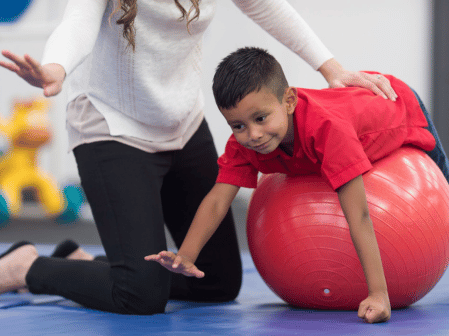OTs & Educators: A Dream Team for Early Learners

What is Occupational Therapy?
Occupational therapy (OT) plays a crucial role in early childhood education, helping children develop essential skills for learning and daily activities. When educators and occupational therapists (OTs) work together, they create a supportive environment that fosters growth and success for all learners. The best news is that this partnership supports not only children with specific needs but the entire classroom!
In an early childhood context, OTs frequently support goals like developing fine motor and gross motor skills, sensory processing and self-regulation, social skills and peer interactions, and self-care tasks, which might include aspects of dressing or feeding. Educators might have students in their classroom community that have an established clinical relationship with an OT or may work in a setting where an OT or OT evaluations are integrated into their school. Some Occupational Therapists support children in their classroom setting, while others work in a designated space or off-site office. While I was teaching, I had the pleasure of collaborating with an OT who visited schools with her amazing OT therapy bus!
Why Might an Educator Collaborate with an OT?
Educators may notice certain challenges in the classroom that can benefit from OT support, such as:
-
a child struggling with developmentally aligned fine motor tasks, like pre-writing grip, hand strength, and dexterity
-
sensory sensitivities, which can sometimes show up as avoidance of specific sensory experiences (distressed by loud noises, not wanting to touch sticky things) or seeking out specific sensory input (needing to jump, push, spin, or roll; finding deep pressure comforting)
-
difficulties with attention or routines
-
social and emotional concerns, such as difficulty engaging with peers or shared activities
By partnering with an OT, educators can implement strategies to help all children thrive, including those with developmental delays, disabilities, and unique learning needs.
The Benefits of OT & Early Childhood Collaboration
OTs provide tailored recommendations to address specific challenges for individual children. Strategies like sensory breaks or adapted materials can make a big difference. OT insights can improve the learning environment for all students. Collaborating with specialists helps early educators gain valuable knowledge and strategies that can be generalized to support everyone. A deeper understanding of children’s developmental growth and unique sensory preferences can impact teachers’ practices in so many ways and help address a variety of student needs with empathy and a solution-focused approach
How Does Collaboration Work?
The steps for establishing connections will vary for each school community. Talk to your program leaders to learn about the process for your setting.
While the specifics will vary, in general OTs and teachers communicate to discuss strategies, brainstorm approaches, and set goals. Ideally, there is open and clear communication between a child’s OT, teacher and family to help with consistency, relay feedback, and celebrate successes! Collaborating with occupational therapists can have a lasting impact on young learners. Educators who embrace these partnerships can create more inclusive, supportive, and developmentally appropriate classrooms. By working together, OTs and educators can ensure every child has the tools to succeed.
Collaboration with occupational therapists can be a tremendous support for children and teachers. Whether we’re helping children feel more successful with physical goals, helping them navigate their day more smoothly, or supporting social skills for meaningful and joyful peer connection, embracing these partnerships can create more inclusive, supportive, and developmentally appropriate classrooms. By working together, OTs and educators can ensure every child has the tools to succeed.
Resources
BLOG: We Have More Than Five Senses (Part 1): Proprioception
BLOG: We Have More Than Five Senses (Part 1): Vestibular Input
WEBINAR: Understanding Sensory Processing and Sensory Mismatch
WEBINAR: Self-Regulation in Early Childhood
Register for March’s Webinar: The Intersection between Communication and Regulation
Register for April’s Webinar: Supporting Children’s Social & Emotional Learning through Play
Register for May’s Webinar: Beyond the Therapy Room: Using Therapeutic Strategies Through Play to Support ALL Children
Recommended Products

Christine Murray is an Early Childhood Education Specialist with Becker’s Education Team.
As an educator, coach and leader, Christine is inspired by the curiosity, joy and wonder that children so generously model for us. She earned her M.A. in Innovative Early Childhood Education at the University of Colorado Denver and loves collaborating with and supporting others in the field. Grounded in relationships and guided by empathy, Christine is always learning, connecting and creating.
